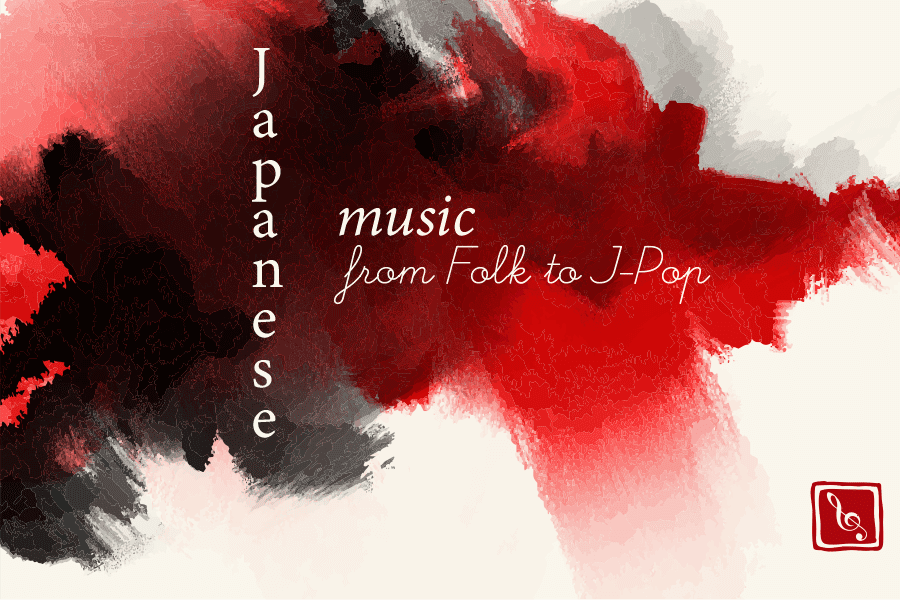There is a huge perception of Japanese culture through the world of television and music. Through the eyes of American lenses, it is easy to dispose of the history of folk music in Japan as the persona as the perception through media can be thrown to a stereotypical nature. However, through the measures of Gagaku and Min’yo, the land of Japan is filled with authentic, purifying beautiful music that is heavily incorporated to the vibrant sounds we hear today.
Japanese Music Is Rooted with Authentic Musical Sounds
Harajuku queens and stylish handsome young men dance around my naïve head when I think of Japan. The ultra hi depth technological world of Tokyo gives me a faint image of what the beautiful evolutionary region upholds in many aspects of life. But as I reflect on my focused studies through my adolescence at an art school, I vividly remember the musical customs Japan upheld throughout the years. Even through western influence, Japan managed to fully invest and incorporate the folk traditional sound into modern day music mayhem.
Obsession is an understatement when it comes to my sister’s love for anime. Growing up, manga soundtracks filled my sisters’ room as she would immerse herself into the sea of Japanese cartoons. Although it took me a bit of time to understand the pandemonium, I quite enjoy the world of manga! With amazing messages and sensational music, the cartoon genre has given me an intriguing listen to the sounds of Japanese music! How incorporated is the modern sound of Japanese musical aspects to the traditional music of their past?
Dating back as early as the 13th century, original pieces of Japanese music arise and are played by mendicant Fuke sect priests of Zen Buddhism. “Ongaku” meaning music in Japanese shows a wide range of musical performances with distinct styles. According to Wikipedia through traditional and modern Japanese musical research, Japan is the largest physical music market in the world and the 2nd largest overall music market. Through many outlets such as karaoke venues composed by record labels, traditional music has managed to sink its way into a full partnership with western music. Starting in the Nara period, Japanese music was formed into two aspects of traditional musical entities: “Shomyo” and “Gagaku”. “Shomyo” surrounds the Japanese music style through Buddhist chants. Mainly used in the “Tendai” and “Shingon” sects, the style is divided into two parts: “Ryokyoku” and “Rikkyoku”.
“Gagaku” is of a classical music nature. Based in China and heavily mixed into the Japanese culture, “Gagaku” was performed at the Imperial Court in Kyoto in the 7th century, the traditional sound is performed by the Board of Ceremonies in the Tokyo Imperial Palace in today’s modern time. “Gagaku” is divided into “kangen”, which is composed of instrumental music and “bugaku”, which is traditional dance music accompanied by “Gagaku”. Although the Fuke sect halted in the 19th century the original pieces are still being incorporated in Japanese Musical interpretation today.
The Instruments Of Japanese Music
The important aspects of Japanese music are transpired by the workings of its instrumental content. The short-necked lute called the “Biwa” are traditional instruments that are performed by “Biwa Hoshi”. The performers recite folk tales and stories. Other performance groups such as “Moso” travel local areas to perform a variety of semi religious efforts to purify and bring good luck to the people around Japan. The Japanese drum (“Taiko”) is used through implications and other varieties of musical genres. During the 7th century the drums were used to communicate through battle and commands. Today, “Taiko” continues to be used as a religious entity in the music of Buddhism and Shinto. Through the traditional sounds of “Min’yo” (a genre of folk music) the three stringed instruments, “Shamisen” along with the Taiko accompanied the traditional music style. Other instruments of Japanese descent are the “Shinobue”, a flute-like instrument. The bell is known as “Kane”, the 13 stringed zithers known as the “Koto”, and the similar banjo instrument called the “Sanshin”.
Instruments such as the electric guitar and synthesizers were later incorporated into the ancestral music genre.
With the arrival of Western music, music such as military marches became popular in Japan which later formed the style “Gunka”. “Shoka”, which developed through the efforts of implementing western music to schools. Throughout the time, “kayokyoku” became a major industry of pop music. Artists such as “Misora Hibari” embodies the pop music culture of traditional Japanese culture. Classical music from the Japanese educator, “Isawa Shuji” adopted much of the western classical structure in return shaping a new form of classical music to the Japanese people. “Enka” is a style of Japanese Music that is heavily rooted with the “Min’yo” texture.
Modern Japanese Music
The Japanese culture adapted the highly spinning wheel of global music. Latin music as well as Jazz (during World War II) became a token of curiosity for the music of Japan. Modern Japanese pop music jumped onto the scene in the 1960’s incorporating a thick rock heavy sound influenced by “The Beatles”. Throughout the years, Idol music (Japanese boy and girl bands) have been captivating the global pop world such as the vintage Japanese group “SMAP”. With the American hit of Micheal Jackson’s “Thriller” album in 1984, the Japanese culture became enticed by modern dance fused songs and dance. Through the modern scene today, places such as Tokyo have adapted to the world of Hip Hop and Electropop, becoming recognizable genres from Japan on a global perspective.
The sounds of Japan feed the soul in a traditional nature. Judging from the history and abundant energy put forth toward the preservation of traditional folk music, Japan is a prime example of the progression through music endeavors that maintain a cohesive ancestral sound. There is no stopping the music Japanese train any time soon.
Photo: Shutterstock / Edited by: Martina Advaney
More music reviews here:
Support us!
All your donations will be used to pay the magazine’s journalists and to support the ongoing costs of maintaining the site.
Share this post
Interested in co-operating with us?
We are open to co-operation from writers and businesses alike. You can reach us on our email at [email protected]/[email protected] and we will get back to you as quick as we can.










